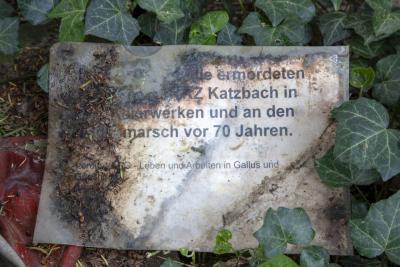“When your legs no longer carry you” – Dachauer for a while: Antoni Bryliński
When Antoni Bryliński gave an interview to Karin Korte from the “Book of Remembrance” project in October 2009, he smiled mischievously and said: “Memory is a good thing when you still have it.” Bryliński did have it and could describe his experiences during the war in detail.
Now the face of Antoni Bryliński, who died in 2011 at the age of 92, can be seen on posters throughout the city of Dachau. It is the continuation of the poster series “Für eine Zeit Dachauer”, which the Development Association for International Youth Exchange and Memorial Work started in April 2020 to mark the 75th anniversary of the liberation of the concentration camp. Every month since then, a portrait of a former concentration camp prisoner has been posted around Dachau. There are twelve portraits in total. In January, the series was devoted to Antoni Bryliński.
He was born on 15 April 1918 in Wagrowiec, Poland, approximately 50 kilometres northwest of Poznań. His childhood was not a happy one. His father was old and infirm, his mother died in 1937. Antoni Bryliński had to help support his family and in 1932 he began an apprenticeship in a grocery store. Later, he worked as a salesman in the grain trade until war broke out. Following the German occupation, Wagrowiec’s name was changed to “Eichenbrück” and the German Employment Office took over the allocation of available workers. In the early hours of 6 May 1940, Antoni Bryliński was summoned to the Employment Office, where around 100 Polish men had to line up. The German head of the Employment Office walked up and down the line picking out men. As he did so, he also had the men show him their teeth - just like an inspection at a cattle market. The next day, those selected had to go to the train station and were to be taken to Germany as “seasonal workers”. Antoni Bryliński was one of them.
He was first taken to Rehfelde near Berlin and had to carry out forced labour on an estate for a year. At the end of June 1944, he and his friend were interrogated by the Gestapo and they were taken to prison in Potsdam. The charge was “Listening to enemy broadcasts”. Ten prisoners had to sleep on the bare floor in a single cell. Antoni developed large festering ulcers on his legs. On 4 October 1944, he arrived at the concentration camp in Dachau. The prisoners had to walk from the train station to the camp on foot - Antoni Bryliński had to be carried by his comrades because he was no longer able to walk on his own. He was given prisoner number 112731. A fellow prisoner made sure that he was taken to the infirmary. Antoni was operated on because of the festering phlegmon. Although the wounds had not yet healed, he was moved to Block 16 and suffered from terrible hunger.
On 7 February 1945, Antoni Bryliński was taken to the Augsburg-Pfersee subcamp together with others who had been selected by the SS. When they arrived there, the prisoners were greeted by the camp senior who threatened them unequivocally: “The convalescence is over – this rules here”, said the ‘kapo’ or prison functionary pointing to the cudgel. A lack of hygiene, hunger and hard work made Antoni Bryliński sick again – the ulcers on his leg flared up again. He returned to Dachau and on 29 April 1945, where he experienced the liberation of the camp by the US Army.
In August 1945, Antoni Bryliński returned to Poland. He worked as an office worker in various companies and in 1950 married Irena Losiniecka, who had also been a forced labourer in Rehfelde. They had three children. Antoni Brylińsk visited Dachau several times, the last time in 2010.
Süddeutsche Zeitung, Author: SZ
(online: https://www.sueddeutsche.de/muenchen/dachau/dachau-kz-zeitzeuge-1.51732…, published: 14 January 2021, 12.19 p.m.)
[1] ‘Dachauer’ is a person from Dachau


